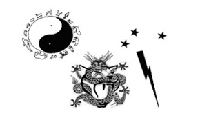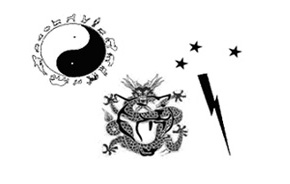 |
 |
 |
 |
 |
 |
 |
| divx 1 | divx 2 | divx 3 | divx 4 | divx 5 | divx 6 | www. |
|
How it was born and how it developed What is T1 When? Why? The method to go along the path How we work Contacts |
 |
You start the journey in the Method widening the bases of psychomotility and working on them with playfulness that is to say without “added tensions”.
You will develop coordination, muscular strength, agility and endurance.
You will also practise some alternative physical techniques, in order to have, even psychologically, escape routes of expression.
Going on practising, the bases will become a way of exploring oneself and a natural building plan for advanced techniques up to “technically perfect”.
NB. Paradoxically a perfect technique is first performed and then thought.
You will use approaches and preparation to the Combat Arts in their Inner and Outer version, in order to have a natural evolution of the disciple’s style and to direct him through therapeutic techniques that stimulate the inner freedom, cleaning the centres of accumulation of tensions.
Tensions may be at an articular-muscular or psychological level and working on the “cleaning of the gesture” you will come to a free and effective natural movement.
These are the 2 main components deriving from the method and they will lead us to increase the quickness of intervention, the strength, the faculties of analysis and judgement and the ability of fast reaction.
“Acting instinctively after having logically taken into account all possibilities”
You will also work in a water environment using the swimming Formation as an ideal training field “beyond everyday life” (we were born to stay on dry land and when you train in the water you are confronted with problems that require a good amount of adaptability and it implies a solution of problems that affects you remarkably both in the water and outside it.)
What is T1
The pair T1 refers to an integrated training. This union of customs and attitudes has been present in every part of the world, in different civilizations and cultures for lots of years.
T represents what we know as: Thunder.
Its origins, history and references meet over the years.
From the Celtic Thunder to the Sacred Thunder of American Indians to Vedic Thunder.
Thunder is also present in various cultures and ages. The Bird of Thunder, or the Bird of Fire, or the Bird of Water, according to different sources, refers to that Bird that appears in the pre-Columbian representations of the Aztecan, Maya and Incan civilizations.
We find references even in the Tibetan, Chinese and Indian cultures. Thunder was the first winner in the fight between good and evil. Before the creation of the human being, of physicalness and even of time. The first fight between good and evil was fought with a sound wave, “at a sound level”... The cry of evil was (the sound of evil) was destroyed, was won, disintegrated by the sound wave of good, the cry of good that was just set off by the Thunder (the sound of good).
It was the Thunder. The Sacred Thunder. In the infinite sidereal space even before the creation of what today we know as big-bang.
The 1, in a lot of kata of the combat arts, is taught to carry out combats in the shortest time, using the smallest quantity of strokes and aiming at the “Path that leads to settle with 1 stroke”.
This is a concept that has been then revived and that is nowadays present in some special unit such as: one shoot one kill, that in addition to the literal meaning, also means: “to finish in the shortest time” or “ to hit, always and only, the target/s”; operative summaries of the tactics: to adapt oneself-to fight-to resolve.
In the eastern philosophy, with the ancient martial laws, the 1 means that an action can be created from nothing; an action that produces at the same time the non-action, that is to say: given an action, there is instantly a reaction (that can be a non-action). This is a cornerstone for a lot of Masters and basis of Mathematics.
The 1 is also the ability to become a complete unit of combat, with real ability of analysis and intervention.
If you became a Staff Officer or a Prime Minister or a cleaner soldier, you would be all of them, with your dignity and your way of acting but you would also be able to conclude at a high level (therefore with ability of analysis) the various operative realities (therefore with ability of intervention).
When?
There is no age problem to approach the integrated T1.
There is no age-limit because it is a psychophysical training with breathing techniques, athletic training also with soft exercise, body expression, yoga, martial arts: techniques and training (inner and outer styles), water activities, playing stages. Therefore it can grant specific requests due to the pupil’s age or to other needs.
The needs of every pupil, even if attending a class, are held in great esteem.
It is possible to start since early childhood with teachers trained to work with children also in a water environment. We work also with preadolescents and teenagers and we teach them the training techniques they can develop by themselves over the years.
We can work with men and women, continuing and refining their already acquired experiences, suggesting more or less complete training forms, or integrating pre-acquired specific training.
We can work with elderly people, suggesting them breathing exercises, Qi-Gong, soft exercises, contact with the water.
We work also with disabled persons.
Why?
The benefits of sport, when it is true sport, are clear and obvious for everyone.
To live a sport experience in a playful way let us act in the most pleasant and freest way. You get rid off strict patterns and you learn in a more natural and amusing way. Even athletes benefit from it because they can loosen tensions that are often inherent their role.
In the same way, for children, “playing” is their way of relieving tensions due to growing.
We talk about psychophysical training because all our expressions are regulated by the psychic sphere and the physic sphere.
T1 operates at a psychophysical level; every kind of training, with its teaching method and subjects, envelopes the entirety of the human being, in its components of body and mind.
The method and the integrated training T 1 have also a therapeutic origin.
Its specific components are:
Tai Chi C’huan (it’s the loom, the basis on which we work)
Qi gong (breathing techniques and soft exercises)
Stretching on Meridians (besides classical stretching this kind of stretching works with methods similar to those used by acupuncture and shiatzu)
First principles of Inner and Outer Martial Arts (Aikido, Thai Boxe, Wing Tsu, Yoga, Kung Fu)
Personal defence (use of combat techniques for every kind of attack, even with weapons)
Athletic training (free exercises with or without tools)
Swimming (use of swimming abilities)
Running, trekking and walks close to the nature.
For thousands of years and in a lot of places, “Inner Combat Arts” (breathing techniques and exercises) and their fusion with “Outer Combat Arts” have been a therapeutic and socialising method. In ancient China these Arts, these methods, were an integral and basic part of medical treatment and the doctor was paid only when the whole village, he took care of, was well; it meant he was doing his job very well.
Today there are persons who still hinder, out of ignorance, the use of these natural practises and, unfortunately, there are persons who, out of interest, pass themselves off as teachers or researchers.
However, western medicine nowadays recognizes the properties of Tai Chi C’huan, Inner “Combat” Art (world lectures – mid nineteen nineties – on neurovegetative diseases and on Alzheimer’s disease, admit that the experience of Tai Chi C’huan or simply watching people doing Tai Chi C’huan, improved enormously the conditions of the patients and slowed down the disease).
Yoga, Qi Gong and Stretching on Meridians (breathing techniques and soft exercises) are by now recognized as excellent practises and effective remedies to reach a good harmony and to get stronger at a psychophysical level.
Some nursery schools and some rehabilitation centres are beginning to offer these practises.
Pedagogical characteristics and the benefits of swimming and of exercises in the water, are collected in a lot of sports medicine, pedagogical and psychomotility treatises.
We can say the same for Outer “Combat” Arts.
The method to go along the path
The “Path” in the method
Exercises aren’t only linked to their performance but also to a philosophy..., a way of thinking and living. It will be possible to modify oneself in a natural way, from the foundations..., exalting positive behaviours and controlling the negative ones.
The “Path” is the way to form a mature, well-balanced, natural and lively person. It gives you the ability to know yourself, to test yourself, to learn and to value; therefore, if you know yourself you can know what is round you. The practice (whatever way you consider it) is inspired and motivated by an ethic which crosses a method..., letting us go along the “Path”.
The method is obviously different for each person. The teacher’s task is to give the pupil the tools to know him/herself; a good teacher sees the pupil’s potential tools and he lets him/her know them.
Working with the body, you shape the mind. These are character-forming disciplines. They operate at a physic and psychological level.
Benefits
Above all you develop a greater harmony and psychophysical strength. If you act in a group, these are very socialising experiences and you learn to control yourself. This new ability lets you control impulsive reactions but if you are an inhibited person it lets you activate your dozing impulses.
You gain a greater self-control, you learn to value different situations and to react appropriately. Exercises are a synthesis of training to combat arts and therapeutic method. They have a very important role in the psychophysical training; they aim at obtaining an energy re-balancing; they work on the correct posture and on naturalness.
Prerequisites aren’t required; these exercises can integrate other sports training or artistic practises.
As you gain experience, you learn to control your emotions but, obviously, non entirely; otherwise we would be like machines.
You learn to show yourself spontaneously, achieving your aims; for example you learn to remove negative aspects or to live with them but directing them to your aims. Programmatic proposals are meant to include, as much as possible, training levels and age brackets. The activity is studied in a global way, it works directly and indirectly on the muscular, skeletal, circulatory and neurological systems.
How we work
We don’t have offices in any place but we co-operate with any facility or anyone who shares our interests and attitudes about formation, education, training and working method.
We provide the Instructor.
Premises, pupils, bureaucratic papers, are charged to the persons we co-operate with.
Together with the pupils and their technical manager we evaluate the kind of training to set up.
Besides the integrated training T 1 instructors, we can provide additional instructors specialized in specific activities.
We can also co-operate to carry out martial choreographies and/or to give technical supervision in audiovisual productions.
We can offer security forces for concerts, parties, meetings and other brotherhood, peace and entertainment activities.
Contacts
Luca Trabanelli-Eliometri
e-mail: uct1@uct1.net

 |
 |
 |
 |
 |
 |
 |
| divx 1 | divx 2 | divx 3 | divx 4 | divx 5 | divx 6 | www. |